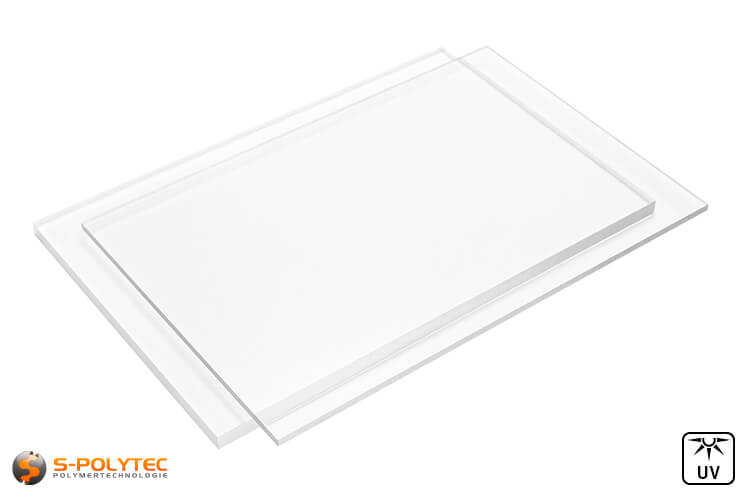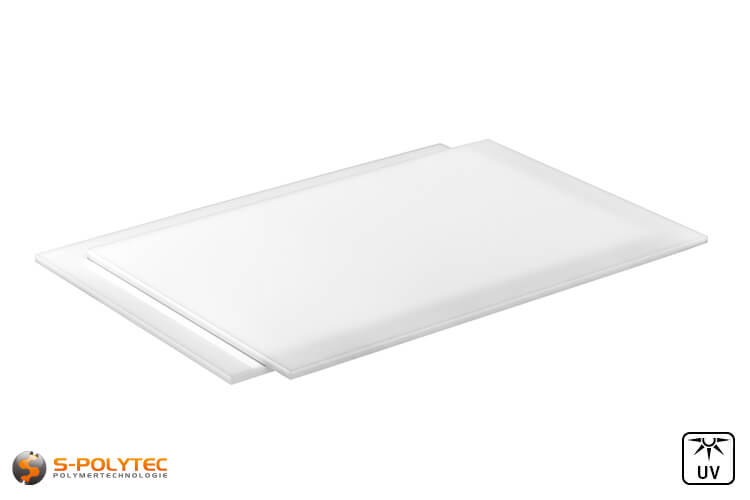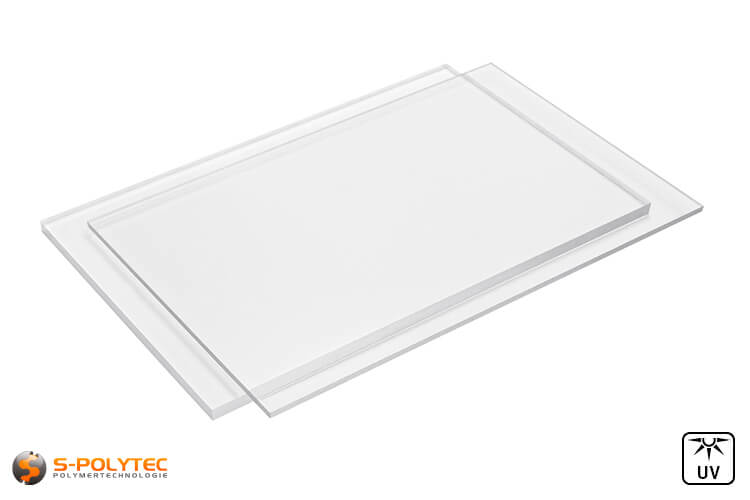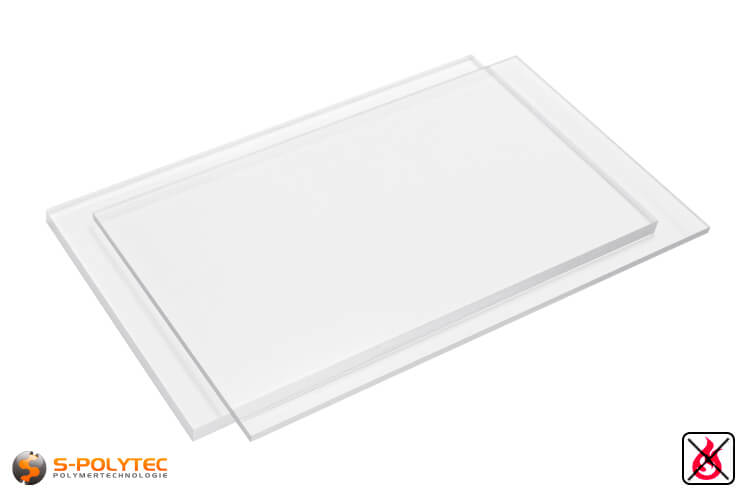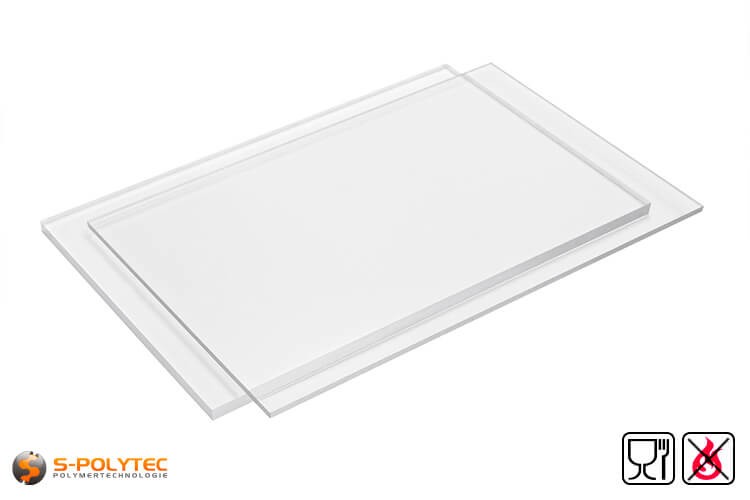
Transparent plastic sheets at a glance
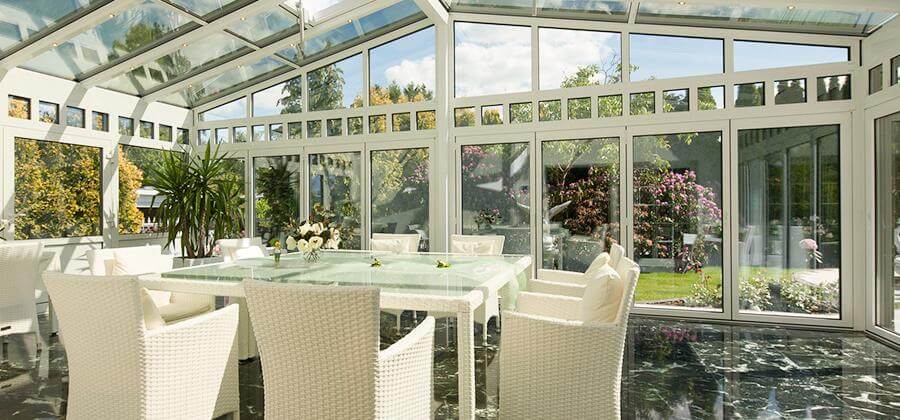
Transparent plastics are available in a wide variety of designs, but not every plastic is suitable for every purpose. We would like to show you the advantages and disadvantages of each transparent plastic.
Transparent plastic sheets with a high light transmission are very often searched and bought in our shop.
We often receive questions in advance about which plastic can be used for which application and whether a particular plastic has certain properties.
We would like to give you a brief overview of our transparent plastics with all their advantages and disadvantages in order to make it easier for you to choose the right plastic for your applications.
Transparent plastic sheets at a glance
Not all plastics are the same, and a distinction is made between amorphous polymers and semi-crystalline polymers in the case of thermoplastics, to which our plastic sheets belong. This is particularly noticeable in the optical properties of the respective plastics.
Semi-crystalline polymers
In semi-crystalline polymers - which also include our polyethylene sheets and polypropylene sheets - the polymer chains are aligned parallel to each other to a large extent. With these plastics, light is scattered by the crystalline structures, so that they are usually cloudy (translucent) or opaque (opaque).
Amorphous polymers
In amorphous polymers, the polymer chains are spatially unevenly distributed. These plastics are usually transparent. Plastics such as polystyrene, polymethyl methacrylate (better known as acrylic glass), or polycarbonate are highly transparent polymers and have a similar or higher transparency than conventional glass.
However, if these amorphous polymers contain fillers, such as glass fibres or mineral fillers, the transparency is lost. This is used in particular with polystyrene, because although this plastic is highly transparent in its original form, it is also very brittle, which makes processing much more difficult.
Transparent plastics
In our online shop, we offer you a whole range of transparent plastic sheets. However, not all plastics are the same and so you must also pay attention to the intended use and physical properties of the transparent plastic sheets.
The basic differences between the plastics are, on the one hand, the temperature ranges in which the plastics can be used. However, the UV and weather resistance of the respective plastics should also be taken into account, especially if outdoor use is envisaged. Other properties that may vary depending on the plastic are break resistance and scratch resistance. Last but not least, the approval according to fire protection standard DIN 4102 B1 (flame retardant) can also be an important criterion when choosing a suitable plastic sheet in transparent design.
Acrylic glass transparent
Acryllic glass opal
Acrylic glass, whose chemical name is polymethyl methacrylate (PMMA for short), is often also referred to by the well-known brand name Plexiglas® (registered brand name of Evonik Performance Materials GmbH as a manufacturer of acrylic glass). Due to its chemical composition, acrylic glass is UV-resistant and can therefore be used both indoors and outdoors. The temperature range for transparent acrylic glass is from -40°C to +90°C.
Acrylic glass has a very high light transmission, which even exceeds the light transmission of inorganic glass (to put it simply: conventional glass panes).
Acrylic glass has a hard surface that is very resistant to scratches, but due to the brittleness of the plastic, it is sensitive to breakage, so that acrylic glass can break when hit or knocked.
Acrylic glass is not approved for use in the food sector and is considered normally flammable and therefore does not meet the DIN 4102 B1 fire protection standard.
Acrylic glass has a low resistance to organic solvents such as benzene, acetone or alcohols and should therefore not be cleaned with alcohol. In addition, acrylic glass can develop stress cracks on the surface due to the effect of alcohol.
The same properties apply to opal acrylic sheets as to transparent acrylic. Thus, acrylic glass in milky glass look is just as UV and weather resistant and has the same high surface hardness, which brings with it good resistance to scratching.
The only difference worth mentioning is the transparency, because acrylic glass in opal is milky, cloudy and therefore opaque, but translucent. The light transmission of opal acrylic glass is about 30%.
- Acrylic glass is naturally UV and weather resistant
- Acrylic glass is insensitive to scratching
- Acrylic glass has a very high light transmission (except for acrylic glass opal)
- Acrylic glass can be used at temperatures from -40°C to +90°C
- Acrylic glass is not food safe
- Acrylic glass is not flame retardant
- Acrylic glass is not particularly impact resistant
- Acrylic glass is not break-resistant
To our transparent acrylic sheets
Polycarbonate
Polycarbonate, which is known under the brand names Makrolon© (Bayer AG) or Lexan© (Sabic), is not UV-stable by nature, but is also available in UV-stabilised variants. The polycarbonate sheets offered in our online shop have UV stabilisation on both sides, so that the transparent sheets can be used indoors and outdoors without any problems.
Polycarbonate stands out above all because of its very high impact resistance and its very good breakage behaviour, because even with the hardest blows, the material does not give way and is considered break-proof. For this reason, polycarbonate is also often referred to as bulletproof glass.
The surface hardness of polycarbonate is, however, not nearly as high as that of acrylic glass, which is why polycarbonate is considered quite scratch-sensitive. In addition, polycarbonate is not approved for use in the food and drinking water sector.
Another decisive advantage of polycarbonate is its temperature range, which extends from -100°C to +120°C, making it the plastic among the transparent sheets we offer with the lowest and highest application temperatures.
Polycarbonate meets the requirements of fire class B2 according to DIN 4102. In sheet thicknesses from 1mm to 6mm, polycarbonate is classified in fire class B1, 'flame retardant', in the case of interior applications.
- Polycarbonate is considered UV and weather resistant (applies to our UV-stabilised types)
- Polycarbonate is extremely impact resistant and shatterproof
- Polycarbonate has a high light transmission
- Polycarbonate can be used at temperatures from -100°C to +120°C
- Polycarbonate meets the fire protection standard DIN 4102 B1 (flame retardant) in thicknesses of 1mm-6mm
- Polycarbonate is not food safe .
- Polycarbonate is sensitive to scratching
Go to our transparent polycarbonate sheets
PVC glass
PVC glass is actually just a common name for plastic sheets made of rigid PVC in a crystal-clear, transparent version. The chemical name of PVC is polyvinyl chloride and, as we call it rigid PVC, it is absolutely free of so-called plasticisers, such as phthalates, which are said to be a health hazard.
PVC is not UV-resistant. Although there are also UV-stabilised variants, the transparent plastic sheet made of PVC glass is a type that is not UV- and weather-resistant, so that these sheets can only be used outdoors under certain conditions (protective laminate, foiling, etc.). In addition, rigid PVC in transparent is not frost-resistant and has a comparably low temperature application range of 0°C to +60°C.
PVC in transparent is considered to have normal impact resistance, which translates to normal breakage behaviour. In addition, the high-gloss surfaces of crystal-clear rigid PVC are normally sensitive to scratches.
PVC in transparent is considered to have normal impact resistance.
The advantages of transparent PVC are its very good chemical resistance and, in particular, its low flammability. Depending on its thickness, PVC glass meets several standards and approvals with regard to fire behaviour and does not continue to burn after the flame has been removed (self-extinguishing).
Like acrylic glass and polycarbonate, PVC is not food-safe and therefore not approved for applications where food is processed.
- PVC glass meets several fire protection standards and approvals depending on its thickness
- PVC glass has very good chemical resistance
- PVC glass has very good light transmission
- PVC glass is not UV and weather resistant
- PVC glass is not food safe
- PVC glass can only be used at temperatures from 0°C to +60°C
Go to our transparent PVC sheets
.PETG
From a chemical point of view, PETG is a polyethylene terephthalate modified with glycol and by nature cannot be used for outdoor applications, as PETG does not have UV- and weather-resistant properties.
PETG is considered an impact and shatter resistant plastic, but cannot match the outstanding shatter resistance properties of polycarbonate. PETG also has a medium surface hardness, which is why it does not scratch too quickly, but cannot be classified as scratch-resistant either.
The important advantages of PETG as a transparent, translucent plastic are that it fulfils the requirements of fire class B1 according to DIN 4102 in thicknesses of 1mm - 8mm and, in particular, that it conforms to food regulations according to FDA and EU 10/2011.
This makes PETG the only transparent plastic we offer in our online shop that is approved for use in the food and drinking water sectors and is considered physiologically safe
In addition, PETG has a very high chemical resistance and is insensitive to low temperatures. The temperature range of PETG is between -40°C and +65°C.
- PETG meets the fire protection standard DIN 4102 B1 (flame retardant) in thicknesses of 1mm-8mm
- PETG is approved for use in the food and drinking water sector
- PETG has very good chemical resistance
- PETG is frost-resistant and can be used from -40°C to +65°C
- PETG is not UV and weather resistant
